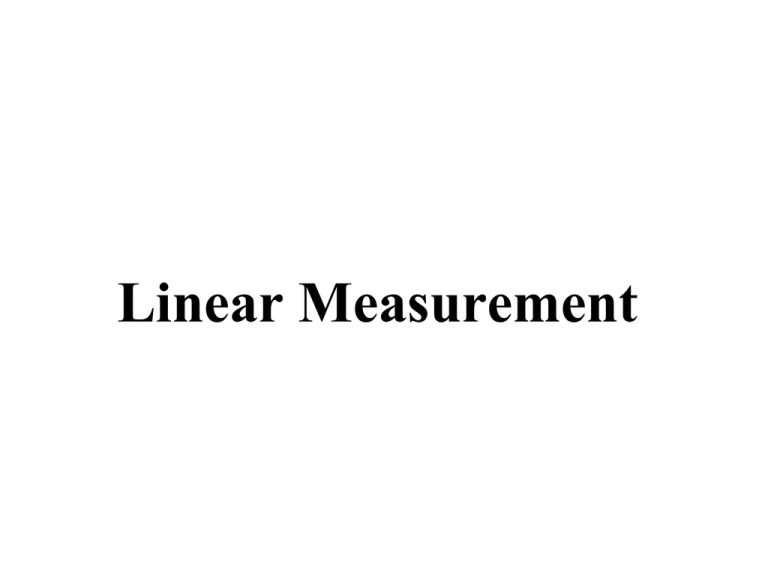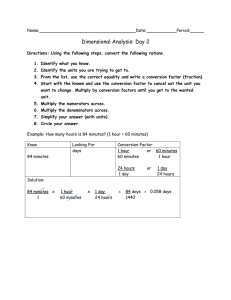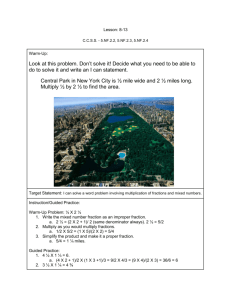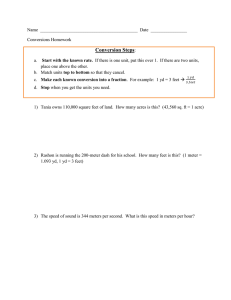1 min
advertisement

Linear Measurement The U.S. system of measurement uses the inch, foot, yard, and mile to measure length. U.S. Units of Length 12 inches (in.) = 1 foot (ft) 3 feet = 1 yard (yd) 36 inches = 1 yard 5280 feet = 1 mile (mi) Unit Fractions 12 in. 1 ft 1 1 ft 12 in. 3 ft 1 yd 1 1 yd 3 ft 5280 ft 1mi 1 1mi 5280 ft To convert from one unit of length to another, unit fractions may be used. A unit fraction is a fraction that equals 1. To convert 60 inches to feet, multiply by a unit fraction that relates feet to inches. The unit fraction should be written so that the units we are converting to, feet, are in the numerator and the original units, inches, are in the denominator. Unit fraction units converting to 60 in. 1 ft 60 1 ft 60 ft 60 in. 5 ft 1 12 in. 1 12 12 original units Metric System of Measurement The basic unit of length in the metric system is the meter. A meter is slightly longer than a yard. It is approximately 39.37 inches long. Like the decimal system, the metric system uses powers of ten to define units. Metric System of Measurement Metric System of Measurement Prefix kilo hecto deka Meaning 1000 100 10 deci centi milli 1/10 1/100 1/1000 Metric Unit of Length 1 kilometer (km) 1000 meters (m) 1 hectometer (hm) 100 m 1 dekameter (dam) 10 m 1 meter (m) 1 m 1 decimeter (dm) 1/10 or 0.1 m 1 centimeter (cm) 1/100 or 0.01 m 1 millimeter (mm) 1/1000 or 0.001 m Metric System of Measurement The most commonly used measurements of length in the metric system are the meter, millimeter, centimeter, and kilometer. Converting Between Measurements As with the U.S. system of measurement, unit fractions may be used to convert from one unit of length to another. The major advantage of the metric system is the ease of converting from one unit of length to another. Since all units of length are powers of 10 of the meter, converting from one unit of length to another is as simple as moving the decimal point. Converting Between Measurements Listing units of length in order from largest to smallest helps keep track of how many places to move the decimal point when converting. Start km hm dam End m dm cm mm 2 units to the right Using the listing of units of length, convert 3.5 m to centimeters. 3.50 m = 350. cm or 350 cm 2 places to the right The process of converting from one unit to another is called dimensional analysis, or unit analysis. To convert units, multiply by one or more conversion factors. A conversion factor is a ratio of two quantities that are equal but use different units. For example, to convert inches to feet you would use the ratio 1 ft as a conversion factor. 12 in. Multiplying by a conversion factor is like multiplying by 1. 1 ft = 12 in. 12 in. 12 in. = 1 ft = 1 1 ft Additional Example 1: Using Conversion Factors to Solve Problems The average American uses 580 pounds of paper per year. Find this rate in pounds per month, to the nearest tenth. Convert the rate 580 pounds per year to pounds per month. 580 lb 1 yr 1 yr 12 mo 580 lb 12 mo 48.3 lb per month To convert the second amount in a rate, multiply by the conversion factor with that unit in the first quantity. yr lb lb = • Divide out like units. yr mo mo Divide 580 by 12. The average American uses 48.3 pounds of paper per month. Check It Out! Example 1 Sam drives his car 23,040 miles per year. Find this rate in the number of miles driven per month, to the nearest mile. Convert the rate 23,040 miles per year to miles per month. 23,040 mi 1 yr = 23,040 mi 12 mo 1 yr 12 mo To convert the second amount in a rate, multiply by the conversion factor with that unit in the first quantity. Divide out units. mi • yr = mi yr mo mo Divide 23,040 by 12. = 1920 per month Sam drives his car 1920 miles per month. Additional Example 2: Problem Solving Application A car traveled 60 miles on a road in 2 hours. Find this rate in feet per second. 1 Understand the Problem The problem is stated in units of miles and hours. The question asks for the answer in units of feet and seconds. You will need to use several conversion factors. List the important information: • Feet to miles • Hours to minutes • Minutes to seconds 5280 ft 1 mi 1h 60 min 1 min 60 s 2 Make a Plan You know the conversion factor that converts miles to feet. So multiply by each conversion factor separately, or simplify the problem and multiply by several conversion factors at once. 3 Solve 60 mi = 2h (60÷2) mi (2÷2) h = 30 mi Convert to miles per hour. 1h Create a single conversion factor to convert hours directly to seconds: 1h 60 min hours to minutes 1h • 60 min hours to seconds = 30 mi 1h • 5280 ft 1 mi minutes to seconds • 1 min = 60 s 1 min 60 s 1h 3600 s 1h Set up the conversion factors. 3600 s Solve Continued 3 5280 ft • 1 h 30 mi • = 3600 s 1 mi 1h = 30 • 5280 ft • 1 1 • 1 • 3600 s = Divide out like units. 158,400 ft = 44 ft 3600 s 1s The car was traveling 44 feet per second. 4 Look Back A rate of 44 ft/s is less than 50 ft/s. A rate of 60 miles in 2 hours is 30 mi/h or 0.5 mi/min. Since 0.5 mi/min is less than 3000 ft/ 60 s or 50 ft/s and 44 ft/s is less than 50 ft/s, then 44 ft/s is a reasonable answer. Check It Out! Example 2 A train traveled 180 miles on a railroad track in 4 hours. Find this rate in feet per second. 1 Understand the Problem The problem is stated in units of miles and hours. The question asks for the answer in units of feet and seconds. You will need to use several conversion factors. List the important information: 5280 ft • Feet to miles 1 mi 1h • Hours to minutes 60 min • Minutes to seconds 1 min 60 s 2 Make a Plan You know the conversion factor that converts miles to feet. So multiply by each conversion factor separately, or simplify the problem and multiply by several conversion factors at once. 3 Solve First, convert 180 miles in 4 hours into a unit rate. 180 mi = 4h (180 ÷ 4) mi (4 ÷ 4) h = 45 mi 1h Create a single conversion factor to convert hours directly to seconds: 1h 60 min hours to minutes 1h • 60 min hours to seconds = 45 mi 1h • 5280 ft 1 mi minutes to seconds • 1 min = 60 s 1 min 60 s 1h 3600 s 1h Set up the conversion factors. 3600 s 3 Solve Continued 1h 5280 ft 45 mi • • Divide out like units. = 3600 s 1 mi 1h 45 • 5280 ft • 1 = 237,600 ft = 66 ft = 1 • 1 • 3600 s 3600 s 1s The train was traveling 66 feet per second. 4 Look Back A rate of 66 ft/s is more than 50 ft/s. A rate of 180 miles in 4 hours is 45 mi/h or 0.75 mi/min. Since 0.75 mi/min is more than 3000 ft/60 s or 50 ft/s and 66 ft/s is more than 50 ft/s, then 66 ft/s is a reasonable answer. Additional Example 3: Physical Science Application A strobe lamp can be used to measure the speed of an object. 1 The lamp flashes every 100 of a second. A camera records the object moving 52 cm between flashes. How fast is the object moving in m/s? Use dimensional analysis to check the reasonableness of your answer. 52 cm 1 s 100 Use rate = distance . time Additional Example 3 Continued It may help to eliminate the fraction 52 cm = 100 • 52 cm 1 100 • 1 s s 100 100 = 5200 cm 1s 1 first. 100 Multiply numerator and denominator by 100. Additional Example 3 Continued Convert centimeters to meters to see if the answer is reasonable. 5200 cm 1s 1m = 5200 cm • 100 cm 1s 52 m 5200 m = = 1s 100 s The object is traveling 52 m/s. Multiply by the conversion factor. Check It Out! Example 3 A strobe lamp can be used to measure the speed of an object. 1 The lamp flashes every 100 of a second. A camera records the object moving 65 cm between flashes. How fast is the object moving in m/s? 65 cm 1 s 100 Use rate = distance . time Check It Out! Example 3 Continued It may help to eliminate the fraction 65 cm = 100 • 65 cm 1 100 • 1 s s 100 100 = 6500 cm 1s 1 first. 100 Multiply numerator and denominator by 100. Check It Out! Example 3 Continued Convert centimeters to meters to see if the answer is reasonable. 6500 cm 1s 1m = 6500 cm • 100 cm 1s 65 m 6500 m = = 1s 100 s The object is traveling 65 m/s. Multiply by the conversion factor. Lesson Quiz 1. You drive 136 miles from your house to your aunt’s house at the lake. You use 8 gallons of gas. How many yards does your car get to the gallon? 29,920 yd gal 2. A cheetah was timed running 200 yards in 6 seconds. What was its average speed in miles per hour? ≈ 68 mi/h Convert from: mile inch inch foot yard To: Multiply by: kilometer (km) 1.609347 millimeter (mm) 25.4 centimeter (cm) 2.54 meter (m) 0.3048 meter (m) 0.9144 Which of the following represents the longest length? A. B. C. D. 248 mm 21 cm 2m 0.9 km Answer: 0.9 km Convert half of a mile, three yards, and two feet into total feet. Answer: 2651 feet Mark has three 650-milliliter bottles of lemonade. Is one 2-liter bottle large enough to hold all of the lemonade from the three bottles? How much more or less would there be? Answer: Yes. (Total is 1950ml = 1.95 liters) 50 ml more room left in 2 liter bottle.





